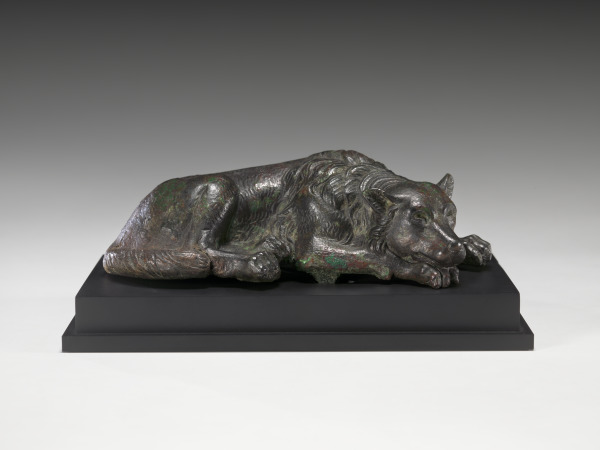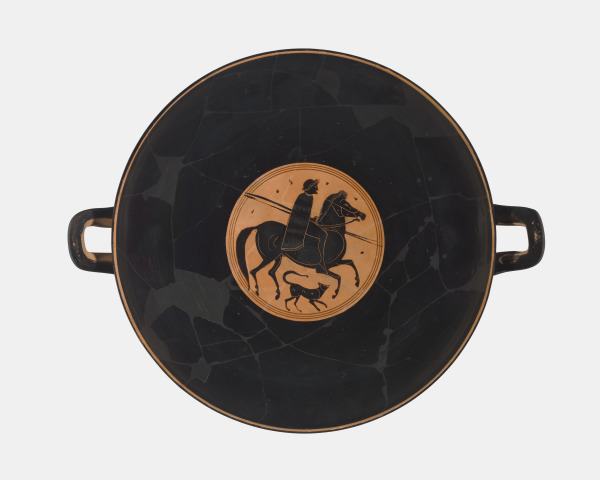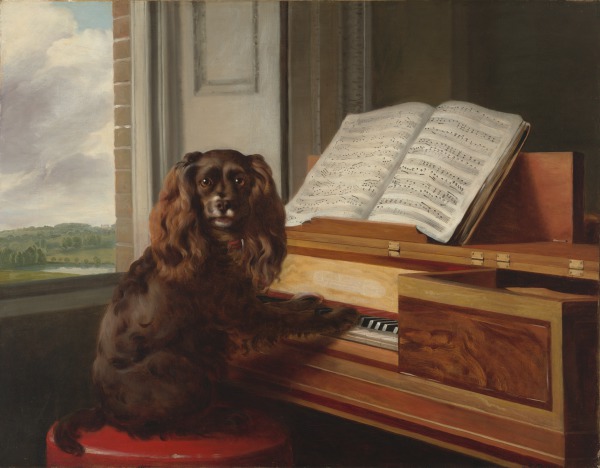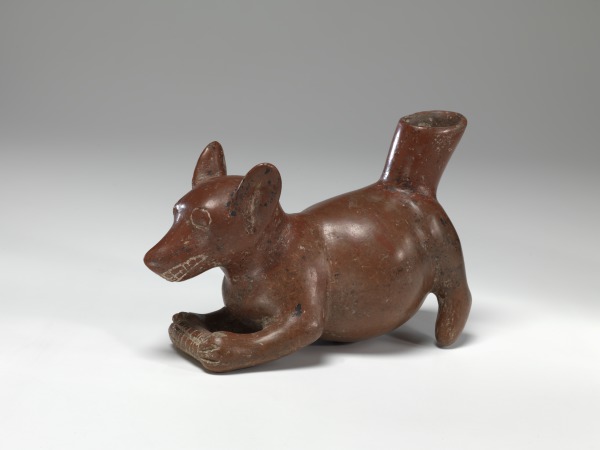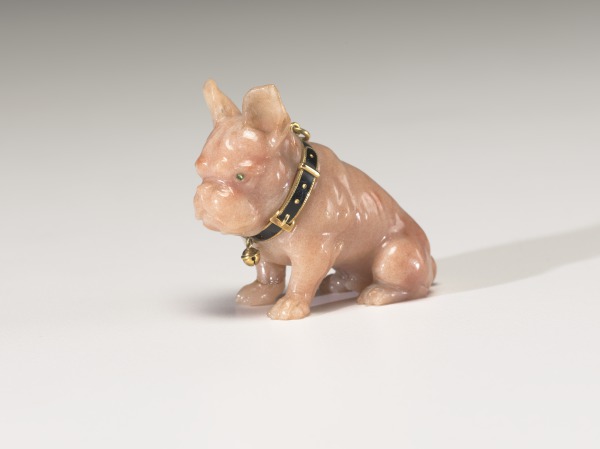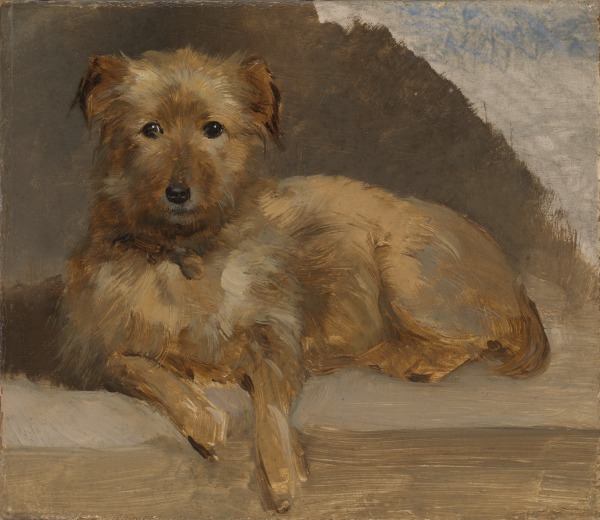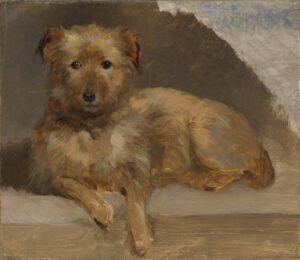
Dogs at VMFA!
Dogs, those furry, tail-wagging, bed-stealing companions, and art muses have left their pawprints on history as symbols of loyalty, protection, and friendship. From ancient depictions to modern interpretations, they continue to inspire artists, embodying a profound connection and deep bond between humans and our four-legged friends. Explore some of VMFA's favorite canines!
Dogs’ lives are too short. Their only fault, really.
―Agnes Sligh Turnbull, novelist
Statuette of Molossian Hound
Ancient Galleries, Level 2
Given that a large part of the Roman Empire was agricultural, the role of dogs in guarding livestock and farms was critical. Think of them as “paw-tectors”!
This small, bronze dog would have most likely decorated or guarded a chest or a ceremonial chariot. A fitting role for this type of dog. The breed represented is typically called a Molossian hound and was prized as a guard dog by the Greeks and Romans. Molossians are mentioned with some frequency in ancient literature and although they no longer exist in their original form, they are thought to be ancestors of modern breeds such as the English Mastiff, St. Bernard, Great Pyrenees, and Rottweiler to name a just a few.
As the 1st century BC Roman poet Virgil said: “Never, with these dogs on guard, need you fear a midnight thief in your stalls, or the onslaught of wolves.”
Molossians could also be used for herding. Herding dogs were fed a vegetarian diet to prevent them developing a taste for the animals they were supposed to be protecting. Smart idea!
Black-figured Cup
Ancient Galleries, Level 2
In this scene on a Greek cup, a small dog trots faithfully beside its owner on horseback. The man in the scene wears a travelling cloak indicating the dog is along for a journey. Just as today, dogs could be faithful companions that should be treated with kind words. The Greek historian, Arrian says one should pat one’s dog, caress its head, pulling gently on the ears, and speak its name along with a hearty word or two—“Well done!” “Good girl!”—by way of encouragement. After all, he says, “dogs enjoy being praised, just as noble men do.”
Of course, even companions can be useful. Dogs similar to greyhounds were bred to keep their owner warm and since a dog’s body temperature is naturally higher than a human’s, this proved useful when there was no heat in the home, as in antiquity. So, for thousands of years, people have shared their beds with their furry friends. And with over 70 million dogs living in households in the United States, many people might be thinking beware of dog…stealing your covers!
Portrait of an Extraordinary Musical Dog
Great Hall, Level 2
The mystery of this image has dog lovers wagging their tails in excitement! While many dog (and cat!) owners are familiar with the playful antics of their pets tickling the ivories, (or more recently, their keyboards while on Zoom), this portrait could have a deeper meaning. It may show an exemplar of successful spaniel breeding or be meant as a satire on human infant prodigies, or even as loyalist propaganda since the sheet music is sometimes identified as “God save the King/Queen.” It may also be simply a portrait of a beloved pet, immortalized in a humorous manner. Without a doubt, however, the artist must have had a strong general appreciation for the remarkable intelligence of dogs if not a somewhat comic attitude to this “extraordinary” specimen.
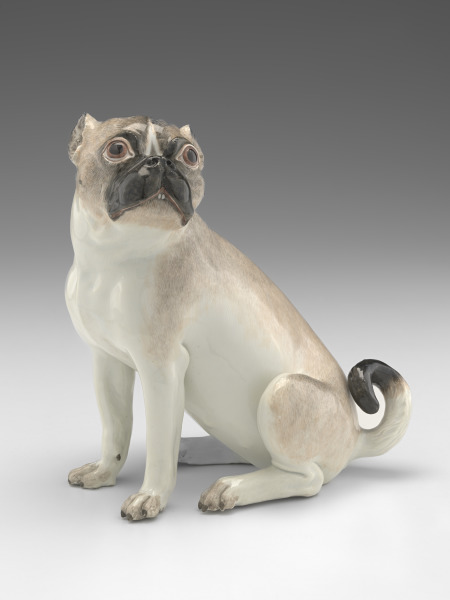
Large Female Pug, ca. 1741, Meissen Porcelain Manufactory (German, active from 1710), porcelain. Virginia Museum of Fine Arts, purchased with funds provided by Lynne and Robert Glasser, 2022.136
Large Female Pug
European Art, Saunders Collection, Level 2
You can almost hear the snoring of this small pug! Pugs most likely originated in China as far back as 400 BC and were bred as companions to the wealthy, owing to their good nature and adaptability. They were first imported to Europe by the East India Company in the early 1700s. Because of their rather novel appearance and character, pugs were associated with a spectrum of character traits, including wittiness, liveliness, and high-spiritedness, as well as loyalty, lovingness, and fidelity. They quickly became the most fashionable dogs of the European Court.
Johann Joachim Kandler, the main designer and modeler of the Meissen manufactory at the time this sculpture was made, designed several large sculptures of almost life-size pugs. This sculpture was very likely made by Meissen at the request of a member of a chivalric order called “The Order of the Pug.” In Bavaria and Saxony (free states in Germany), the popularity of pugs inspired the name or the order. While the name may seem a bit humorous, the order was created by Catholics who, by a Papal Decree in 1738, were no longer allowed to become Freemasons. Pugs were chosen as the symbol of this order as they were considered loyal, trustworthy, and steady. Members carried a silver medallion with an image of a pug and initiates even had to wear a dog collar and scratch at the door to be admitted!
Dog with a Corncob
Pre-Columbian Galleries, Level 2
Bent down in a stance familiar to dog owners, holding a treasured treat, in this case, a corn cob, this naturalistic and amusing depiction of a dog is characteristic of West Mexican ceramics. However, what might appear as a simple representation of a favorite companion may not be so simple. While dogs were frequent subject matter in the West Mexican Colima culture, close inspection of this piece suggests that such innocent depictions are often symbolically complex. The distinctly human manner in which this dog grips the corncob suggests that the figure may in fact be a shaman transformed into a dog.
Among the few domesticated animals in North America, dogs were common companions of warriors in battle. Numerous Ancient American cultures believed that dogs played a vital role in guiding the deceased through the underworld into the afterlife and this figure may have been a funerary offering left in a tomb. Thus, these ceramics not only showcase artistic excellence but also provide a glimpse into the cultural beliefs surrounding dogs, highlighting their dual roles as loyal companions and mystical guides in the realms of both the living and the spirits.
French Bulldog
European Art, Fabergé, Level 2
The Romanovs had a particular fondness for French bulldogs. Throughout the late 19th and early 20th centuries, French bulldogs became favorite companions to the Romanovs, especially among the younger members of the family. Their charm and affectionate nature made them cherished pets that they wished to honor through the creations of Carl Fabergé. Not only did Fabergé receive several commissions to create opulent accessories for these canine companions, including jeweled collars, but also miniature, hardstone sculptures of these family members. These unique commissions demonstrated the Romanovs’ affection for their four-legged friends and also showcased Fabergé’s exceptional artistry. These pieces stand as a testament to the enduring bond between the Romanovs, their beloved French bulldogs, and the brilliant craftsmanship of Carl Fabergé.
A Terrier on a Step
British Sporting Art, Mellon Collection, Level 3
“I wish to bring out …. human feeling and human thought ― endurance, impudence, pain, joy and the rest―through the medium of animal life”―Edwin Landseer
This wire-haired terrier sits on a step, perhaps taking a break or waiting for the opportunity to chase vermin, as terriers were bred to do. The artist, Sir Edwin Landseer, was a prominent 19th-century artist, renowned for his remarkable ability to capture the spirit and personality of dogs in his paintings and sculptures. His works often depict dogs as symbols of loyalty, courage, and devotion. Although a sketch, not technically a finished painting, Landseer has captured the facial expression of this dog with more detail than the rest of the work.
His profound love for dogs and other animals earned him the title of “The Painter of Animals” during his lifetime. His deep admiration for canines shines through in every stroke of his brush, making his artwork a heartwarming celebration of the human-animal bond.
